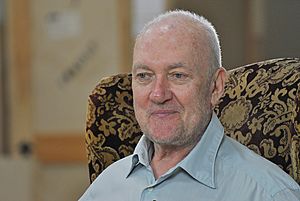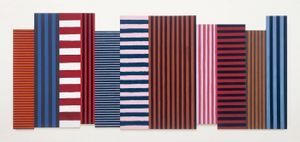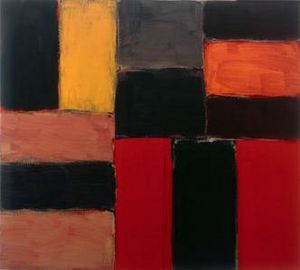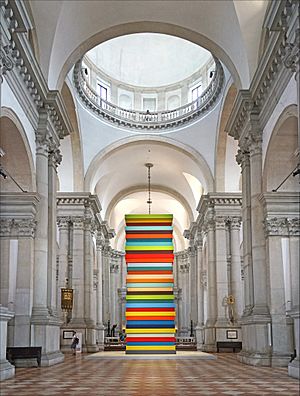Sean Scully facts for kids
Quick facts for kids
Sean Scully
|
|
|---|---|
 |
|
| Born | 30 June 1945 Dublin, Ireland
|
| Nationality | Irish |
| Education | Croydon College of Art (1965–1968) Newcastle University (1968–1972) Carpenter Center for the Visual Arts at Harvard University (1972–1973) (graduate fellowship) |
| Known for | Painting, printmaking, sculpture, photography, art and writing |
| Movement | Geometric abstraction and emotional abstraction |
Sean Scully (born 30 June 1945) is a famous artist. He creates paintings, prints, sculptures, and photographs. His art is shown in museums all over the world. He was even nominated twice for the important Turner Prize award.
In 1975, he moved from London to New York. There, he helped change art from a style called Minimalism to Emotional abstraction. Minimalism used very simple shapes and colors. Emotional Abstraction, however, allowed artists to put more feelings and deeper meanings into their work. Sean Scully also taught art at many universities. His ideas and interviews are in a book called Inner, published in 2016.
Contents
Early Life and Art Beginnings
Sean Scully was born in Dublin, Ireland, in 1945. When he was four, his family moved to London. They lived in different places in a working-class area.
By age nine, Sean knew he wanted to be an artist. From 15 to 17, he worked as a typesetter in a printing shop. This job later inspired some of his art. From 17 to 20, he worked full-time in various jobs. But he still went to evening art classes. He studied figurative painting, which means painting real-life objects or people.
He once worked as a plasterer's helper. During that time, he often visited the Tate Milbank museum. He loved seeing Van Gogh's Chair by Van Gogh. At 18, in 1963, Sean loaded flattened boxes onto trucks. This experience of stacking things later became a big idea in his art.
Art Education and Inspirations
In 1965, at age 20, Sean Scully started studying art full-time. He went to Croydon College of Art in London. He also studied printmaking at Camberwell School of Art. Later, in 1968, he went to Newcastle University. While at Newcastle, a play called Waiting for Godot deeply affected him.
A trip to Morocco in 1969 also inspired him. He loved the colorful stripes woven into local tents and clothes. In 1972, he received a special scholarship. This allowed him to study at Harvard University in the US. During this time, he started trying new art methods. He used things like tape and spray paint in his work.
Sean Scully's Art Career
Early Career: 1970–1980
Sean Scully's first art show in London was a big success. All his artworks were sold. He taught at art colleges like Chelsea College of Art and Design. He also kept painting in his studio in Rotherhithe, London.
In 1975, when he was 30, Sean received a special award. This allowed him to move to New York for two years. In New York, he made friends with other artists. One friend was Robert Ryman, and he met many people in the art world.
In the 1970s, Sean combined two art styles. He mixed American Minimalism (simple art) with Op art (art that plays tricks on your eyes). He used layers and grids to create new kinds of art. Minimalism greatly influenced him in New York. For a few years, he mostly used grey colors. He created a series of 'Black paintings'.
In 1979, he started The Catherine Paintings series. He shared his studio with artist Catherine Lee, who was his wife at the time. For this series, he chose one important painting from each year they were together. These paintings formed his own special collection.
Moving Beyond Minimalism: 1980–1982
By 1980, Sean felt he needed to move beyond Minimalism. He wanted to add more human feelings and ideas to his art. He traveled to Morocco and Mexico many times. He believed these trips helped him understand what art should be. He wanted his art to show the interesting and beautiful parts of human nature. He felt that art needed to bring back feelings, stories, and spiritual ideas.
In 1981, a big show of Sean Scully's art happened in Birmingham. This show proved he was moving away from Minimalism. He started using more colors and freehand stripes. His brushstrokes became visible, unlike the strict lines of earlier minimalist art.

His 1981 painting, Backs and Fronts, was a major turning point. It was shown in a 1982 exhibition and made a big impact. Artist Gillian Wearing said this painting "broke the logjam" of American minimalist art.
Geometric Abstraction: 1982–Present
In 1982, Sean started working with art dealer David McKee. This was a very important partnership that lasted ten years. That summer, he made small artworks on wood panels. He was at an artist's colony in Montauk, New York. He named these pieces Ridge, Plum, and Bear, after nearby islands.
He also started using strong geometric shapes with rich textures and colors. His painting Heart of Darkness is a good example. It was inspired by a famous story. In 1983, Sean started working with printmaker Mohammad O. Khalil. This was his first time working with a printmaker. It began his lifelong love for making prints. That year, he also won a special Guggenheim Fellowship award for his art.
In 1984, the Museum of Modern Art featured Sean's work. In 1985, he had his first solo museum show in America. It was at the Carnegie Institute in Pittsburgh and then went to the Museum of Fine Arts, Boston. Many big museums started buying his large paintings. His paintings from this time were very big and had a strong physical presence.
By 1987, Sean's art became simpler and smaller. He started using lighter colors, like in his 1988 painting Pale Fire. In 1988, while painting with watercolors in Mexico, he created a new idea. This led to his famous Wall of Light series, which explores buildings and light.
In 1989, the Whitechapel Gallery in London held a solo show for Sean. It then traveled to Madrid and Munich. These were his first solo shows in mainland Europe. A famous art critic, Robert Hughes, wrote about Sean in TIME magazine in 1989. This helped make Sean even more well-known.
In 1988, his painting Why and What (Yellow) used a piece of steel for the first time. By 1991, he used even more steel. He placed oil paintings on linen inside large steel panels. He also started using checkerboard patterns often. He had first tried this idea in the mid-1970s.
In 1992, while teaching at Harvard, Sean went back to Morocco. He filmed a BBC documentary about artist Henri Matisse, who had also visited Morocco. In 1993, The Catherine Paintings were shown for the first time. This exhibition was in Fort Worth, Texas.
In 1994, he opened another studio in Barcelona, Spain. He returned to Morocco in 1995 to spend more time there. His photographs from this trip are called Atlas Walls. In 1995, Sean moved back to New York. He got a big new studio in Chelsea, Manhattan. His first painting made there was Chelsea Wall.
He was invited to speak at many universities. He also took part in important discussions about modern art at Oxford University. In 1997, Sean's photographs were shown for the first time in Bilbao, Spain. In 1998, he took part in a discussion at the Metropolitan Museum of Art. This was connected to an exhibition by artist Richard Pousette-Dart.
He visited Santo Domingo in 1999, and his photos from there became Santa Domingo for Nené. That year, his prints were shown in big exhibitions in Vienna, Austria, and Gravelines, France. A book listing all his prints from 1969 to 1999 was also published.
2001–2013: Exhibitions and Teaching
In 2001, the Modern Art Museum of Fort Worth bought all eighteen Catherine paintings. Each painting represented a year from 1979 to 1996. These paintings now have their own special room in the museum, which opened in 2002. From 2002 to 2007, Sean was a Professor of Painting. He taught at the Academy of Fine Arts, Munich, Germany.

In 2004, a large exhibition of his work opened in Finland. It then traveled to Germany and the National Gallery of Australia. While in Australia, Sean explored the red desert.
From 2005 to 2006, Sean Scully's Wall of Light series was shown in many US museums. It started in Washington D.C. and traveled to Fort Worth, Cincinnati, and finally the Metropolitan Museum of Art. This series received great praise. The same year, Sean traveled with students to Inisheer, an island off the Irish coast. There, he took the Aran portfolio of photographs.
In 2006, the Hugh Lane Gallery opened "The Sean Scully Room." This is a special, permanent display of his art. The Bibliothèque nationale de France also held an exhibition of his prints. In 2007, a big show called Sean Scully: A Retrospective opened in Barcelona. It then traveled to museums in Saint-Étienne and Rome. The National Gallery of Art in Washington D.C. invited Sean to give an important lecture in 2007.
In 2010, a tour of his important early works from the 1980s began in Ireland. It then traveled to Leeds and Ludwigshafen am Rhein.
In 2011, the Chazen Museum of Art opened a new part of their museum. It featured a solo exhibition of Sean's eight-part Liliane paintings and other works. In 2012, Sean had nine more solo museum exhibitions. These included shows at the Philadelphia Museum of Art, MIMA, Kunstmuseum Bern, and IVAM in Valencia, Spain.
Recent Works and Exhibitions: 2018–Present
In 2018, Sean Scully had fourteen public exhibitions around the world. This included a huge sculpture called Boxes of Air in Mexico City. Paintings were also installed in the horse stalls of an iconic pink stable. Other museum shows were in Moscow, Newcastle, Tilburg, St Petersburg, Karlsruhe, and Yorkshire Sculpture Park.
In 2019, the exhibition Sean Scully: Sea Star opened at The National Gallery, London. It showed Sean's work alongside paintings by J. M. W. Turner. On April 6, 2019, a documentary film about him, Unstoppable. Sean Scully & The Art of Everything, aired in the UK. For the 58th Venice Biennale, Sean presented Sean Scully: Human. This exhibition of recent paintings and a new sculpture, Opulent Ascension, was shown in Venice.
Other Creative Works
Music
Sean's mother, Holly, was a singer. Sean became very interested in rhythm and blues music as a teenager. He even owned and ran an R&B club in South London. For a short time, he was in an R&B band with his brother and a friend.
In 2016, the musician Billy Martin worked with Sean Scully. Billy performed with Sean's large steel sculpture Boxes of Air. This led to a live outdoor music piece called ‘Boxing for Sean’.
In 2019, the music group Merzouga released a 46-minute sound piece. It was called "The Language of Light - Music to the Work of Sean Scully." It featured Sean's writings and his voice. It was first broadcast in Finland in December 2019.
Writing
Sean Scully started writing about art and his own work in the 1980s. However, he began writing more regularly from 1996 onwards. In 2016, a book called Inner: the collected writings and selected interviews of Sean Scully was published.
Personal Life
Sean became a father at 19, when his son Paul was born in 1965. Sadly, Paul died in a car accident in 1983 at age 18. While at Newcastle University, Sean met Rosemary Purnell. They married in 1971 and later divorced. Sean married artist Catherine Lee in 1978, and they divorced in 1998. In 2006, he married artist Liliane Tomasko. Their son, Oisin Scully, was born in 2009.
Famous Quotes
- "Art, especially abstract art, has to be a moral act. If not, it's likely to just be decoration."
- "Why stripes? Because they can be anything. And they can be anything because they are nothing. To make nothing into something is more interesting than making something into something else."
- "Artistic culture, to me, is like a huge rug that is constantly folded and unfolded by us. Every time it’s turned over, turned out, unfolded: it shows something new or something overlooked that now seems new."
Images for kids
-
Crate of Air, 2018. This sculpture was shown at the Inside Outside exhibition in Yorkshire Sculpture Park.




